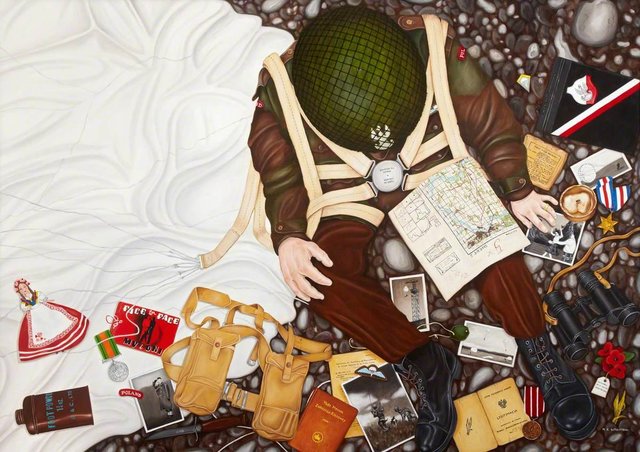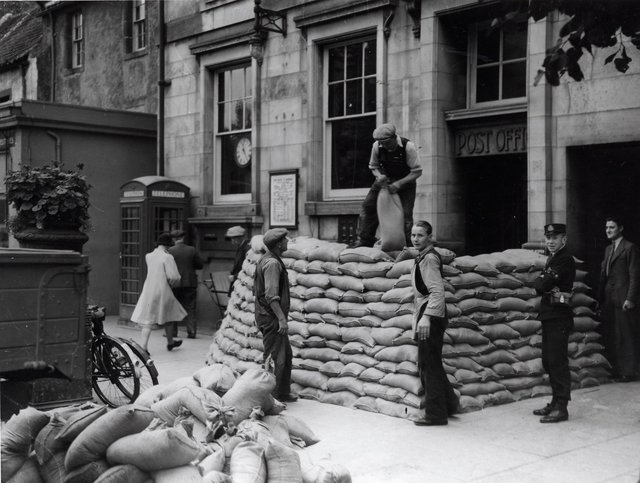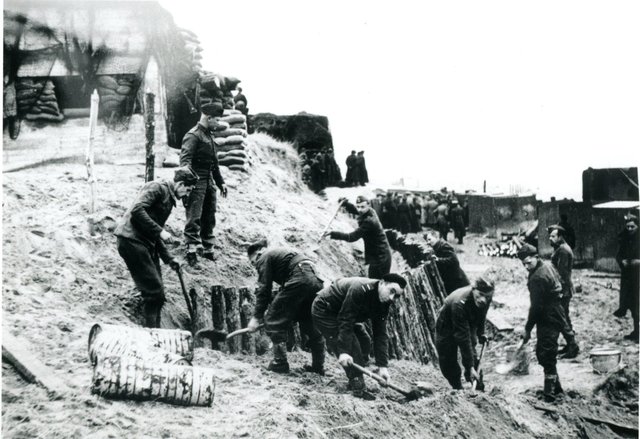Polski spadochroniarz siedzi na ziemi, otoczony przez czaszę spadochronu, pamiątki i przedmioty osobiste, na kolanach ma rozłożoną mapę. Pośród przedmiotów znajdują się polska laleczka i symbol dziwnego kraju, w którym się znalazł – szkocki placek mięsny „Scotch pie”.
A Polish paratrooper is seated on the ground, surrounded by the canopy of his parachute plus personal items and memorabilia, with a map open on his knee. Among the items are a Polish doll and a symbol of the strange country he has arrived in – a Scotch pie.

To scena uwieczniona na dużym płótnie przez Marie Louise Wrightson – obraz pod tytułem „Wspomnienia polskiego spadochroniarza” można zobaczyć w Muzeum St Andrews w Fife. Sugestywna praca towarzyszy wystawie pamiątek po polskiej brygadzie spadochroniarzy utworzonej w Szkocji 80 lat temu.
Wśród eksponatów są hełm, odznaka z orzełkiem i naszywki noszone podczas ataku alianckiego na Arnhem, a także rozmówki angielsko-polskie, lornetka czy puszka talku do stóp, którą otrzymywał każdy żołnierz przed zmasowany atakiem powietrznym w 1944 roku.
We wrześniu tamtego roku, podczas feralnej operacji Market Garden na Arnhem, w okupowanej przez Nazistów Holandii zrzucono ze spadochronami i szybowcami ponad 10.000 żołnierzy Wspólnoty oraz Polaków, 1.500 z nich zginęło a ponad 6.500 zostało pojmanych.
Na wystawie można też zobaczyć kartę identyfikacyjną wydaną wkrótce po utworzeniu przez Polaków na uchodźctwie w Leven (Fife) 1. Samodzielnej Brygady Spadochronowej (23 września 1941). Przedmioty są częścią dużej kolekcji militariów związanych z brygadą, która została podarowana muzeum w Fife (obecnie prowadzonemu przez organizację charytatywną OnFife), kiedy plany utworzenia muzeum poświęconego polskim weteranom nie doszły do skutku.
The scene is depicted in Memories of a Polish Paratrooper, a large-canvas painting by Marie Louise Wrightson now on public view at the Museum of St Andrews in Fife. The evocative work hangs alongside an exhibition of memorabilia from a Polish parachute brigade formed in Scotland 80 years ago.
A paratrooper’s helmet, metal eagle badge and arm flashes – worn during the Allied assault on Arnhem – are among the exhibits on show.
Other items include an English-Polish phrasebook, binoculars and a tin of foot powder – given to each soldier prior to the massive airborne operation in 1944.
In September that year, the ill-fated Operation Market Garden involved dropping more than 10,000 Commonwealth and Polish troops by parachute or glider at Arnhem in Nazi-occupied Holland, with 1,500 killed and more than 6,500 captured.
Also displayed is an ID card issued soon after the formation of the 1st Independent Polish Parachute Brigade on 23 September 1941, which was formed by Polish exiles in Leven, Fife The items are part of a large collection of military objects linked to the brigade which were donated to the Fife museums service – now run by cultural charity OnFife – when plans by Polish ex-servicemen to create their own museum fell through.


